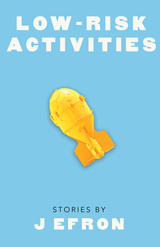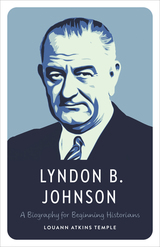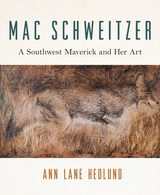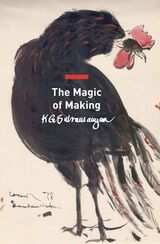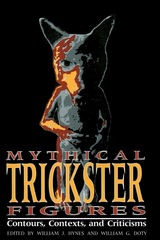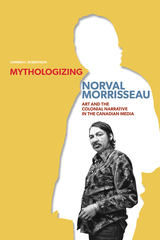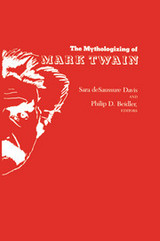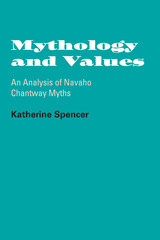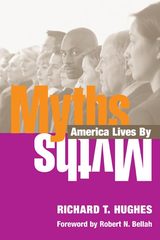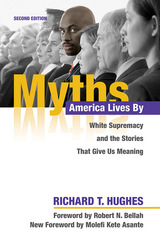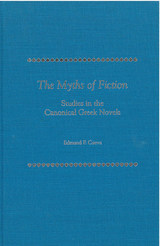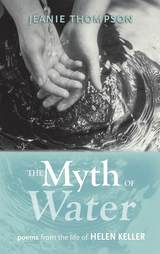 The Myth of Water: Poems from the Life of Helen Keller
Jeanie Thompson
University of Alabama Press, 2016 The Myth of Water is a cycle of thirty-four poems by award-winning Alabama poet and writer Jeanie Thompson in the voice of world-renowned Alabamian Helen Keller. In their sweep, the poems trace Keller’s metamorphosis from a native of a bucolic Alabama town to her emergence as a beloved, international figure who championed the rights of the deaf-blind worldwide.
Thompson’s artfully concatenated vignettes form a mosaic that maps the insightful mind behind the elegant and enigmatic persona Keller projected. Thompson takes readers on the journey of Keller’s life, from some of the thirty-seven countries she visited, including the British Isles, Europe, and Japan to the wellsprings of her emotional awakening and insight. The poems are paired with fascinating biographical anecdotes from Keller’s life and samplings from her writing, which infuse the work with richly-rewarding biographical detail.
The poems in The Myth of Water reveal the discerning subtlety, resiliency, and complexity of the person Thompson perceives Helen Keller to have been. Through a combination of natural intuition, manual signs, Braille alphabets, and lip reading, Keller came to grasp the revolving tapestry of the seasons and the infinite colors of human relationships.
Not a biography or a fictional retelling, The Myth of Water attempts to unlock what moved Keller to her life of service and self-examination. This is a deeply personal story of coming through—not overcoming—a double disability to a fully realized life in which a woman gives her heart to the world.
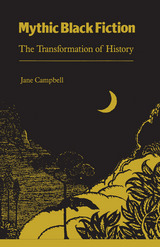 Mythic Black Fiction: The Transformation of History
Jane Campbell
University of Tennessee Press, 1989
Campbell examines Black literature as it seeks to reverse and supplant the various dehumanizing myths promulgated by White American culture. Analyzing fourteen literary works written over more than a century, Campbell shows that this fiction permits Black authors to act as revisionist historians, offering a transcendent view of the future through an exploration of the past.
In searching for rhetorical devices, according to Campbell, Black writers often draw on elements of myth that by definition articulate a culture’s most profound perceptions and can be used in fiction to awaken readers’ deepest urges.
“In a substantial work of literary history, Jane Campbell undertakes to reassess 14 Afro-American historical novels, which ‘encapsulate’ the realities of various periods: slavery, post-Reconstruction, and the decades leading up to the eighties. . . . This book is worth reading by any student of Afro-American literary history.” –Cheryl Clarke, The Black Scholar.
“It is an important study which will enable us to better understand the full range of Afro-American literature.” –Thomas F. Gossett, Georgia Historical Quarterly.
 Mythic Patterns in Ibsen’s Last Plays
Orley I. Holtan
University of Minnesota Press, 1970
Mythic Patterns in Ibsen's Last Plays was first published in 1970. Minnesota Archive Editions uses digital technology to make long-unavailable books once again accessible, and are published unaltered from the original University of Minnesota Press editions.
Until recently critics have tended to regard Ibsen principally as a social dramatist, one who was concerned primarily with the political, social, and moral questions of his time. Radical though he was in the Victorian era, his ideas, with the passage o time, ceased to be avant garde,and for this reason many critics have dismissed him as outdated. Professor Holtan examines a major portion of Ibsen's work, his last eight plays, in a new perspective, however, and finds much that is of lasting significance and interest.
Ibsen's initial impact came with the publication in 1879 of A Doll's House,the play which seemingly advocates a woman's right to leave her husband and children. His reputation as a social dramatist was only furthered by the appearance of his next two plays, Ghosts and An Enemy of the People. But Professor Holtan's study of the plays which came after these identifies in the later plays values which transcend the social problems of their time, penetrating questions of the human spirit itself.
The eight last plays which Professor Holtan examines in this study are The Wild Duck, Rosmersholm, The Lady from the Sea, Hedda Gabler, The Master Builder, Little Eyolf, John Gabriel Borkman, and When We Dead Awaken. In these plays he identifies a mythic pattern and unity based in elements of symbolism and mysticism which have puzzled or annoyed readers and critics for years. In his mythic vision Ibsen's lasting contribution far exceeds that of his invention of the social-problem drama, Professor Holtan concludes.
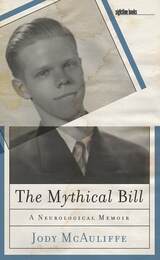 The Mythical Bill: A Neurological Memoir
Jody McAuliffe
University of Iowa Press, 2013 Part medical mystery, part war story, and part social and family history, The Mythical Bill is the story of how one man’s physical and mental pain radiates outward into the life and mind of each member of his family. Weaving together diary entries, correspondence, and scrupulous research, Jody McAuliffe examines her father’s life before, during, and after WWII, seeking answers to the questions of what really happened to Bill McAuliffe and what caused his disintegration. His initial postwar diagnosis was torticollis: a condition of persistent involuntary contraction of the neck muscles, causing the head to be twisted to an abnormal position. But torticollis was only the beginning of Bill’s suffering and his daughter’s efforts to understand it. The condition becomes a metaphor for things that refuse to fall into place: the body not in accord with the mind, the head that turns away from reality. From this drama of dislocation and disjointed truths, two braided selves emerge: the I of Jody and the I of Bill. Through this doubleness, the writer probes a set of questions about how much we shape ourselves and how much we are shaped by forces beyond our control. The Mythical Bill, a moving and unusual book, is for people who suffer the devastating effects of combat on the psyche, for those who encounter any debilitating disease, and for those who grow up with a father only partially present. McAuliffe’s ear-catching, evocative, and often breathtaking writing forces readers to confront the most terrifying question posed by a parent’s mental illness: will I get it too? Her narrative voice is searching, compassionate, and self-deprecating, but cut through with welcome bits of humor in this daughter’s story of confusion, sadness, and loss.
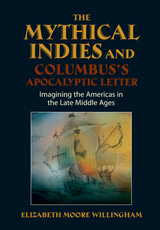 The Mythical Indies and Columbus's Apocalyptic Letter: Imagining the Americas in the Late Middle Ages
Elizabeth Moore Willingham
Sussex Academic Press, 2022 With his Letter of 1493 to the court of Spain, Christopher Columbus heralded his first voyage to the present-day Americas, creating visions that seduced the European imagination and birthing a fascination with those "new" lands and their inhabitants that continues today. Columbus's epistolary announcement travelled from country to country in a late-medieval media event -- and the rest, as has been observed, is history. The Letter has long been the object of speculation concerning its authorship and intention: British historian Cecil Jane questions whether Columbus could read and write prior to the first voyage while Demetrio Ramos argues that King Ferdinand and a minister composed the Letter and had it printed in the Spanish folio. The Letter has figured in studies of Spanish Imperialism and of Discovery and Colonial period history, but it also offers insights into Columbus's passions and motives as he reinvents himself and retails his vision of Peter Martyr's Novus orbis to men and women for whom Columbus was as unknown as the places he claimed to have visited. The central feature of the book is its annotated variorum edition of the Spanish Letter, together with an annotated English translation and word and name glossaries. A list of terms from early print-period and manuscript cultures supports those critical discussions. In the context of her text-based reading, the author addresses earlier critical perspectives on the Letter, explores foundational questions about its composition, publication and aims, and proposes a theory of authorship grounded in text, linguistics, discourse, and culture. This book was awarded the Bibliographical Society of America's St. Louis Mercantile Library First Place Prize in American Bibliography, 2016. *** John Neal Hoover, Executive Director of the St. Louis Mercantile Library Association, described "The Mythical Indies and Columbus's Apocalyptic Letter" as having achieved "magisterial depth" in its subject, and he said that it would likely "not be supplanted for another century, if ever." --Minutes of the Annual Meeting: Report of the Mercantile Library Prize, The Papers of the Bibliographical Society of America 111.4 (December 2017): 551 (Subject: History, Bibliography)
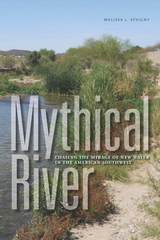 Mythical River: Chasing the Mirage of New Water in the American Southwest
Melissa L. Sevigny
University of Iowa Press, 2016 In a lyrical mix of natural science, history, and memoir, Melissa L. Sevigny ponders what it means to make a home in the American Southwest at a time when its most essential resource, water, is overexploited and undervalued. Mythical River takes the reader on a historical sojourn into the story of the Buenaventura, an imaginary river that led eighteenth- and nineteenth-century explorers, fur trappers, and emigrants astray for seventy-five years. This mythical river becomes a metaphor for our modern-day attempts to supply water to a growing population in the Colorado River Basin. Readers encounter a landscape literally remapped by the search for “new” water, where rivers flow uphill, dams and deep wells reshape geography, trees become intolerable competitors for water, and new technologies tap into clouds and oceans.
In contrast to this fantasy of abundance, Sevigny explores acts of restoration. From a dismantled dam in Arizona to an accidental wetland in Mexico, she examines how ecologists, engineers, politicians, and citizens have attempted to secure water for desert ecosystems. In a place scarred by conflict, she shows how recognizing the rights of rivers is a path toward water security. Ultimately, Sevigny writes a new map for the future of the American Southwest, a vision of a society that accepts the desert’s limits in exchange for an intimate relationship with the natural world.
Mythical Trickster Figures: Contours, Contexts, and Criticisms
Edited by William J. Hynes and William G. Doty
University of Alabama Press, 1997 The first substantial collection of essays about the trickster since 1955
Mythical Trickster Figures, is the first substantial collection of essays about the trickster to appear since Radin’s 1955 The Trickster. Contributions by leading scholars treat a wide range of manifestations of this mischievous character, ranging from the Coyote of the American Southwest to such African figures as Eshu-Elegba and Ananse, the Japanese Susa-no-o, the Greek Hermes, Christian adaptations of Saint Peter, and examples found in contemporary American fiction and drama.
The many humorous trickster stories included are fascinating in themselves, but Hynes and Doty also highlight the wide range of features of the trickster—the figure whose comic appearance often signifies that the most serious cultural values are being both challenged and enforced.
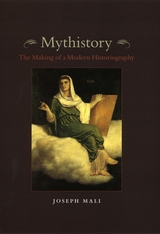 Mythistory: The Making of a Modern Historiography
Joseph Mali
University of Chicago Press, 2003 Ever since Herodotus declared in Histories that to preserve the memories of the great achievements of the Greeks and other nations he would count on their own stories, historians have debated whether and how they should deal with myth. Most have sided with Thucydides, who denounced myth as "unscientific" and banished it from historiography.
In Mythistory, Joseph Mali revives this oldest controversy in historiography. Contesting the conventional opposition between myth and history, Mali advocates instead for a historiography that reconciles the two and recognizes the crucial role that myth plays in the construction of personal and communal identities. The task of historiography, he argues, is to illuminate, not eliminate, these fictions by showing how they have passed into and shaped historical reality. Drawing on the works of modern theorists and artists of myth such as Nietzsche and Wittgenstein, Joyce and Eliot, Mali redefines modern historiography and relates it to the older notion and tradition of "mythistory."
Tracing the origins and transformations of this historiographical tradition from the ancient world to the modern, Mali shows how Livy and Machiavelli sought to recover true history from uncertain myth-and how Vico and Michelet then reversed this pattern of inquiry, seeking instead to recover a deeper and truer myth from uncertain history. In the heart of Mythistory, Mali turns his attention to four thinkers who rediscovered myth in and for modern cultural history: Jacob Burckhardt, Aby Warburg, Ernst Kantorowicz, and Walter Benjamin. His elaboration of the different biographical and historiographical routes by which all four sought to account for the persistence and significance of myth in Western civilization opens up new perspectives for an alternative intellectual history of modernity-one that may better explain the proliferation of mythic imageries of redemption in our secular, all too secular, times.
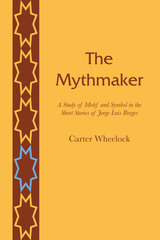 The Mythmaker: A Study of Motif and Symbol in the Short Stories of Jorge Luis Borges
By Carter Wheelock
University of Texas Press, 1969 Readers who are intrigued, though often mystified, by the intellectual fantasies of Jorge Luis Borges will find this book a revelation, a skeleton key to one of the most fundamental and baffling aspects of Borges’s fictions: the pattern of symbolism with an inner meaning. Carter Wheelock’s study reduces a number of literary and intellectual abstractions to concrete terms, enabling the reader to understand Borges’s fantasies in ways that show them to be not so fantastic after all. Indeed, they are amazingly consistent and minutely accurate in their symbolic depiction of the magic universe of the mind. Wheelock also discusses the affinity between Borges’s philosophical idealism and his “esthetic of the intelligence,” the relationship between these and the esthetic ideas of French Symbolism, and the influence on his fictions of the Rubáiyát of Omar Khayyám. Why is it that this “writer’s writer” from the Argentine—erudite, allusive, elusive—has attracted such international attention? In Wheelock’s opinion, it is because he has symbolized in his short stories the fundamental form of the human consciousness, the functioning of the imaginative (world-creating) mechanism, and the eternal battle between form and chaos. The Mythmaker is concerned with elucidating the particulars of Borges’s fictional works, but even as it does so it also reveals their universality.
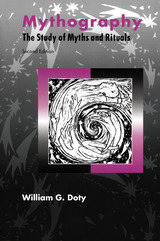 Mythography: The Study of Myths and Rituals
William G. Doty
University of Alabama Press, 2000 This new edition of William Doty's critically acclaimed study provides a comprehensive guidebook to the many schools of interpretation in this burgeoning field William Doty's popular text has been hailed as the most comprehensive work of its kind. Extensively rewritten and completely restructured, the new edition provides further depth and perspective and is even more accessible to students of myth. It includes expanded coverage of postmodern and poststructuralist perspectives, the Gernet Center, mythic iconography, neo-Jungian approaches, and cultural studies, and it summarizes what is new in the study of Greek myth, iconography, French classical scholarship, and ritual studies. It also features a comprehensive index of names and topics, a glossary, an up-to-date annotated bibliography, and a guide to myth on the Internet. Presenting all major myth theorists from antiquity to the present, Mythography is an encyclopedic work that offers a cross-disciplinary approach to the study of myth. By reflecting the dramatic increase in interest in myth among both scholars and general readers since publication of the first edition, it remains a key study of modern approaches to myth and
an essential guide to the wealth of mythographic research available today.
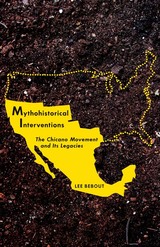 Mythohistorical Interventions: The Chicano Movement and Its Legacies
Lee Bebout
University of Minnesota Press, 2010 Mythohistorical Interventions explores how myth and history impacted the social struggle of the Chicano movement and the postmovement years. Drawing on archival materials and political speeches as well as music and protest poetry, Lee Bebout scrutinizes the ideas that emerged from the effort to organize and legitimize the Chicano movement’s aims.
Examining the deployment of the Aztec eagle by the United Farm Workers union, the poem Yo Soy Joaquín, the document El Plan de Santa Barbara, and icons like La Malinche and La Virgen de Guadalupe, Bebout reveals the centrality of culture to the Chicano movement. For Bebout, the active implementation of cultural narrative was strategically significant in several ways. First, it allowed disparate movement participants to imagine themselves as part of a national, and nationalist, community of resistance. Second, Chicano use of these narratives contested the images that fostered Anglo-American hegemony.
Bringing his analysis up to the present, Bebout delineates how demographic changes have, on the one hand, encouraged the possibility of a panethnic Latino community, while, on the other hand, anti-Mexican nativists attempt to resurrect Chicano myths as a foil to restrict immigration from Mexico.
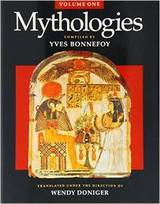 Mythologies
Edited by Yves Bonnefoy
University of Chicago Press, 1991 With 395 original articles written by leading scholars, it is a remarkable encounter with the mythologies of cultures past and present—the web of stories, traditions, rituals, practices, beliefs, divine figures, sacred objects, and great themes that define civilization.
Drawing on a breathtaking array of sources, from the history of religions to anthropology, archaeology, literature, and linguistics, the contributors define a new approach to the understanding of myth in society.
For this first English-language edition, the articles have been rearranged by region or culture. Together they comprise an exceptionally broad, stimulating introduction to the religious and mythical traditions of the world—from the idea of death in Ancient Egypt to the ideology of nationalism in modern Europe. Greeks and Romans are here in force, naturally, but so too are the Bantu, Dinka, and Dogon of Africa and the Armenians, Mongols, and Turks of Asia.
Readers of Mythologies will discover a wealth of fresh primary sources on such little known traditions as those of the Vietnamese—and bold, provocative new interpretations of well-studied traditions, such as those of classical Greece.
The Mythologizing of Mark Twain
Sara Davis
University of Alabama Press, 1984 Readers of Mark Twain seldom doubt his genius, but defining that genius and locating its source continue to challenge students of American literature. Equally elusive is an explanation of the intriguing phenomenon of Twain as a mythic figure, both shaper and embodier of an American mythos. Perhaps no single critical approach can adequately assess the complex force behind Samuel Clemens and Mark Twain. This native genius, our quintessential artist, rightfully provokes a number of powerful responses, as these original essays demonstrate.
 Mythology and the Romantic Tradition in English Poetry
Douglas Bush
Harvard University Press This volume, originally published in 1937, is reissued with a new preface and a few small corrections. A brilliant study of the continuing and changing uses of classical mythology in English poetry, it treats most of the major and many of the minor English poets since 1680 and includes a chapter on the use of myth in American verse. It provides an illuminating overview of English poetry since the end of the Renaissance.
In his Preface to the new printing, Bush briefly surveys the various approaches to classical myth over the centuries. "During the last two generations," he observes, "most of the leading British and American poets (not to mention Rilke and others) have renewed the mythic or mythological tradition with fresh power. Thus, in spite of the accumulated pressures and threats of our time, the vitality and the necessity of myth remain." He also reminisces engagingly about the writing of the book and acknowledges that after three decades he does not find a great deal in it that he would wish to change.
Mythology and Values: An Analysis of Navaho Chantway Myths
By Katherine Spencer
University of Texas Press, 1957 In this book, Katherine Spencer examines Navaho cultural values by studying a specific subset of Navaho mythology: chantway myths, part of ceremonies performed to cure illness. She begins with a summary of the general plot construction of chantway myths and the value themes presented in these plots, then discusses “explanatory elements” inserted by the narrators of the myths. She continues with a deeper analysis of the cultural value judgements conveyed by these myths. At the end of the book, Spencer includes abstracts of the myths she discusses.
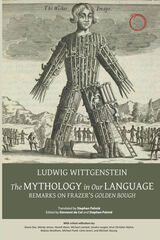 The Mythology in Our Language: Remarks on Frazer's Golden Bough
Ludwig Wittgenstein
HAU, 2018 In 1931 Ludwig Wittgenstein wrote his famous Remarks on Frazer’s “Golden Bough,” published posthumously in 1967. At that time, anthropology and philosophy were in close contact—continental thinkers drew heavily on anthropology’s theoretical terms, like mana, taboo, and potlatch, in order to help them explore the limits of human belief and imagination. Now the book receives its first translation by an anthropologist, in the hope that it can kick-start a new era of interdisciplinary fertilization. Wittgenstein’s remarks on ritual, magic, religion, belief, ceremony, and Frazer’s own logical presuppositions are as lucid and thought-provoking now as they were in Wittgenstein’s day. Anthropologists find themselves asking many of the same questions as Wittgenstein—and in a reflection of that, this volume is fleshed out with a series of engagements with Wittgenstein’s ideas by some of the world’s leading anthropologists, including Veena Das, David Graeber, Wendy James, Heonik Kwon, Michael Lambek, Michael Puett, and Carlo Severi.
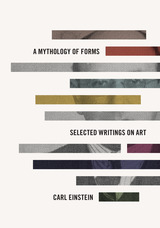 A Mythology of Forms: Selected Writings on Art
Carl Einstein
University of Chicago Press, 2019 The German art historian and critic Carl Einstein (1885-1940) was at the forefront of the modernist movement that defined the twentieth century. One of the most prolific and brilliant early commentators on cubism, he was also among the first authors to assess African sculpture as art. Yet his writings remain relatively little known in the Anglophone world. With A Mythology of Forms, the first representative collection of Einstein’s art theory and criticism to appear in English translation, Charles W. Haxthausen fills this gap. Spanning three decades, it assembles the most important of Einstein’s writings on the art that was central to his critical project—on cubism, surrealism, Pablo Picasso, Georges Braque, and Paul Klee, and includes the full texts of his two pathbreaking books on African art, Negro Sculpture (1915) and African Sculpture (1921). With fourteen texts by Einstein, each presented with extensive commentary, A Mythology of Forms will bring a pivotal voice in the history of modern art into English.
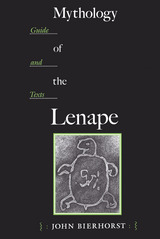 Mythology of the Lenape: Guide and Texts
John Bierhorst
University of Arizona Press, 1995 The Lenape, or Delaware, are an Eastern Algonquian people who originally lived in what is now the greater New York and Philadelphia metropolitan region and have since been dispersed across North America. While the Lenape have long attracted the attention of historians, ethnographers, and linguists, their oral literature has remained unexamined, and Lenape stories have been scattered and largely unpublished.
This catalog of Lenape mythology, featuring synopses of all known Lenape tales, was assembled by folklorist John Bierhorst from historical sources and from material collected by linguists and ethnographers—a difficult task in light of both the paucity of research done on Lenape mythology and the fragmentation of traditional Lenape culture over the past three centuries.
Bierhorst here offers an unprecedented guide to the Lenape corpus with supporting texts. Part one of the "Guide" presents a thematic summary of the folkloric tale types and motifs found throughout the texts; part two presents a synopsis of each of the 218 Lenape narratives on record; part three lists stories of uncertain origin; and part four compares types and motifs occurring in Lenape myths with those found in myths of neighboring Algonquian and Iroquoian cultures.
In the "Texts" section of the book, Bierhorst presents previously unpublished stories collected in the early twentieth century by ethnographers M. R. Harrington and Truman Michelson. Included are two versions of the Lenape trickster cycle, narratives accounting for dance origins, Lenape views of Europeans, and tales of such traditional figures as Mother Corn and the little man of the woods called Wemategunis.
By gathering every available example of Lenape mythology, Bierhorst has produced a work that will long stand as a definitive reference. Perhaps more important, it restores to the land in which the Lenape once thrived a long-missing piece of its Native literary heritage.
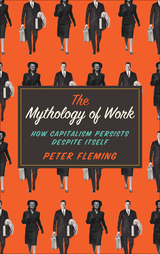 The Mythology of Work: How Capitalism Persists Despite Itself
Peter Fleming
Pluto Press, 2015 Once, work was inextricably linked to survival and self-preservation: the farmer ploughed his land so that his family could eat. In contrast, today work has slowly morphed into a painful and meaningless ritual for many, colonizing almost every part of our day, endless and inescapable.
In The Mythology of Work, Peter Fleming examines how neoliberal society uses the ritual of work—and the threat of its denial—to maintain the late capitalist class order. Work becomes a universal reference point, devoid of any moral or political worth, transforming our society into a factory that never sleeps. Blending critical theory with recent accounts of job-related suicides, office-induced paranoia, fear of relaxation, managerial sadism, and cynical corporate social responsibility campaigns, Fleming paints a bleak picture of a society in which economic and emotional disasters greatly outweigh any professed benefits.
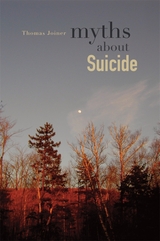 Myths about Suicide
Thomas Joiner
Harvard University Press, 2011 Around the world, more than a million people die by suicide each year. Yet many of us know very little about a tragedy that may strike our own loved ones—and much of what we think we know is wrong. This clear and powerful book dismantles myth after myth to bring compassionate and accurate understanding of a massive international killer.
Drawing on a fascinating array of clinical cases, media reports, literary works, and scientific studies, Thomas Joiner demolishes both moralistic and psychotherapeutic clichés. He shows that suicide is not easy, cowardly, vengeful, or selfish. It is not a manifestation of "suppressed rage" or a side effect of medication. Threats of suicide, far from being idle, are often followed by serious attempts. People who are prevented once from killing themselves will not necessarily try again.
The risk for suicide, Joiner argues, is partly genetic and is influenced by often agonizing mental disorders. Vulnerability to suicide may be anticipated and treated. Most important, suicide can be prevented.
An eminent expert whose own father's death by suicide changed his life, Joiner is relentless in his pursuit of the truth about suicide and deeply sympathetic to such tragic waste of life and the pain it causes those left behind.
 Myths about the St. Bartholomew’s Day Massacres, 1572–1576
Robert Kingdon
Harvard University Press, 1988 An epochal event in French history, the St. Bartholomew’s Day religious massacres are still the subject of controversy. A leading historian of the early modern period, Robert Kingdon, writes about the reactions to the massacres that were published at the time, showing how the relatively new medium of print was used by the Protestants to shape reaction to the catastrophe an early example of the printing press as an agent of social and political change.
Kingdon describes the loosely connected network of printers in Geneva, Basel, Strasbourg, Frankfurt, Heidelberg, London, La Rochelle, and other cities that printed and distributed the grisly accounts of the murders of thousands of Protestants by Catholic zealots. But the pamphlets encompassed more than the making of martyrs. Some linked the massacres with an evil international conspiracy led by the French monarchy, Rome, and Spain. Others were political treatises arguing for a type of government that would no longer claim absolute power and would permit the survival of an ideological minority. Thus, the book contributes to an understanding of the history of printed propaganda and the role of myths in historical events, and illuminates important aspects of international diplomacy and political thought during the period of the later Reformation.
Myths America Lives By
Richard T. Hughes
University of Illinois Press, 2003
The dream of restoring primitive Christianity lies close to the core of the identity of some American denominations---Churches of Christ, Latter-day Saints, some Mennonites, and a variety of Holiness and Pentecostal denominations. But how can a return to ancient Christianity be sustained in a world increasingly driven by modernization? What meaning might such a vision have in the modern world? Twelve distinguished scholars explore these and related questions in this provocative book.
Myths America Lives By: White Supremacy and the Stories That Give Us Meaning
Richard T. Hughes
University of Illinois Press, 2018 Six myths lie at the heart of the American experience. Taken as aspirational, four of those myths remind us of our noblest ideals, challenging us to realize our nation's promise while galvanizing the sense of hope and unity we need to reach our goals. Misused, these myths allow for illusions of innocence that fly in the face of white supremacy, the primal American myth that stands at the heart of all the others.
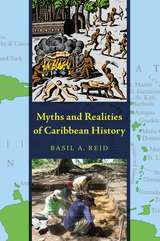 Myths and Realities of Caribbean History
Basil A. Reid
University of Alabama Press, 2009 This book seeks to debunk eleven popular and prevalent myths about Caribbean history. Using archaeological evidence, it corrects many previous misconceptions promulgated by history books and oral tradition as they specifically relate to the pre-Colonial and European-contact periods. It informs popular audiences, as well as scholars, about the current state of archaeological/historical research in the Caribbean Basin and asserts the value of that research in fostering a better understanding of the region’s past.
Contrary to popular belief, the history of the Caribbean did not begin with the arrival of Europeans in 1492. It actually started 7,000 years ago with the infusion of Archaic groups from South America and the successive migrations of other peoples from Central America for about 2,000 years thereafter. In addition to discussing this rich cultural diversity of the Antillean past, Myths and Realities of Caribbean History debates the misuse of terms such as "Arawak" and "Ciboneys," and the validity of Carib cannibalism allegations.
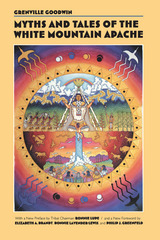 Myths and Tales of the White Mountain Apache
Grenville Goodwin; With a New Preface by Tribal Chairman Ronnie Lupe, and a New Foreword by Elizabeth A. Brandt, Bonnie Lavender-Lewis, and Philip J. Greenfeld
University of Arizona Press, 1994 “This volume contains translations of Apache stories that reflect our distinct view of the world and our approach to life. These myths and fables have survived through untold generations because the truth contained in them is eternal and the moral lessons that they teach are still valid. . . . You can read these stories and catch a glimpse of how our ancestors observed nature, drew metaphors from everyday observations and happenings, and applied the lessons learned to everyday life. Read them and you will see how harmony with nature and the natural world is the goal of every Apache.” —Ronnie Lupe, Tribal Chairman, White Mountain Apache Tribe
These fifty-seven tales (with seven variants) gathered between 1931 and 1936 include major cycles dealing with Creation and Coyote, minor tales, and additional stories derived from Spanish and Mexican tradition. The tales are of two classes: holy tales said by some to explain the origin of ceremonies and holy powers, and tales which have to do with the creation of the earth, the emergence, the flood, the slaying of monsters, and the origin of customs. As Grenville Goodwin was the first anthropologist to work with the White Mountain Apache, his insights remain a primary source on this people.
The Myths of Fiction: Studies in the Canonical Greek Novels
Edmund P. Cueva
University of Michigan Press, 2004 The tradition of historical literature begun by Herodotus and Thucydides molded the early Greek novel. As the genre evolved, however, Greek novels moved away from their historical roots to become more heavily influenced by mythological traditions. Edmund Cueva's new book examines the literary uses to which the ancient novelists put their mythological material. His work offers a stimulating discussion of myths and their rise to prominence as the key feature of the fully developed Greek novel. He also takes into account the impact of the Roman conquest on the development of the Greek novel, the last true literary creation of the Greek world. The Myths of Fiction will interest scholars of Greek literarure, imperial history, literary myth, intertextuality, and comparative literature. Edmund Cueva is Associate Professor and Chair of Classics at Xavier University.
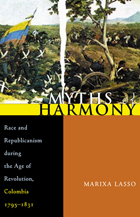 Myths of Harmony: Race and Republicanism during the Age of Revolution, Colombia, 1795-1831
Marixa Lasso
University of Pittsburgh Press, 2007
This book centers on a foundational moment for Latin American racial constructs. While most contemporary scholarship has focused the explanation for racial tolerance-or its lack-in the colonial period, Marixa Lasso argues that the key to understanding the origins of modern race relations are to be found later, in the Age of Revolution.
Lasso rejects the common assumption that subalterns were passive and alienated from Creole-led patriot movements, and instead demonstrates that during Colombia's revolution, free blacks and mulattos (pardos) actively joined and occasionally even led the cause to overthrow the Spanish colonial government. As part of their platform, patriots declared legal racial equality for all citizens, and promulgated an ideology of harmony and fraternity for Colombians of all colors. The fact that blacks were mentioned as equals in the discourse of the revolution and later served in republican government posts was a radical political departure. These factors were instrumental in constructing a powerful myth of racial equality-a myth that would fuel revolutionary activity throughout Latin America.
Thus emerged a historical paradox central to Latin American nation-building: the coexistence of the principle of racial equality with actual racism at the very inception of the republic. Ironically, the discourse of equality meant that grievances of racial discrimination were construed as unpatriotic and divisive acts-in its most extreme form, blacks were accused of preparing a race war. Lasso's work brings much-needed attention to the important role of the anticolonial struggles in shaping the nature of contemporary race relations and racial identities in Latin America.
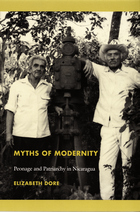 Myths of Modernity: Peonage and Patriarchy in Nicaragua
Elizabeth Dore
Duke University Press, 2006 In Myths of Modernity, Elizabeth Dore rethinks Nicaragua’s transition to capitalism. Arguing against the idea that the country’s capitalist transformation was ushered in by the coffee boom that extended from 1870 to 1930, she maintains that coffee growing gave rise to systems of landowning and labor exploitation that impeded rather than promoted capitalist development. Dore places gender at the forefront of her analysis, which demonstrates that patriarchy was the organizing principle of the coffee economy’s debt-peonage system until the 1950s. She examines the gendered dynamics of daily life in Diriomo, a township in Nicaragua’s Granada region, tracing the history of the town’s Indian community from its inception in the colonial era to its demise in the early twentieth century. Dore seamlessly combines archival research, oral history, and an innovative theoretical approach that unites political economy with social history. She recovers the bygone voices of peons, planters, and local officials within documents such as labor contracts, court records, and official correspondence. She juxtaposes these historical perspectives with those of contemporary peasants, landowners, activists, and politicians who share memories passed down to the present. The reconceptualization of the coffee economy that Dore elaborates has far-reaching implications. The Sandinistas mistakenly believed, she contends, that Nicaraguan capitalism was mature and ripe for socialist revolution, and after their victory in 1979 that belief led them to alienate many peasants by ignoring their demands for land. Thus, the Sandinistas’ myths of modernity contributed to their downfall.
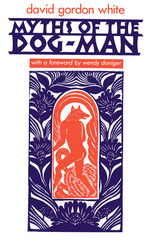 Myths of the Dog-Man
David Gordon White
University of Chicago Press, 1991 "An impressive and important cross-cultural study that has vast implications for history, religion, anthropology, folklore, and other fields. . . . Remarkably wide-ranging and extremely well-documented, it covers (among much else) the following: medieval Christian legends such as the 14th-century Ethiopian Gadla Hawaryat (Contendings of the Apostles) that had their roots in Parthian Gnosticism and Manichaeism; dog-stars (especially Sirius), dog-days, and canine psychopomps in the ancient and Hellenistic world; the cynocephalic hordes of the ancient geographers; the legend of Prester John; Visvamitra and the Svapacas ("Dog-Cookers"); the Dog Rong ("warlike barbarians") during the Xia, Shang, and Zhou periods; the nochoy ghajar (Mongolian for "Dog Country") of the Khitans; the Panju myth of the Southern Man and Yao "barbarians" from chapter 116 of the History of the Latter Han and variants in a series of later texts; and the importance of dogs in ancient Chinese burial rites. . . . Extremely well-researched and highly significant."—Victor H. Mair, Asian Folklore Studies
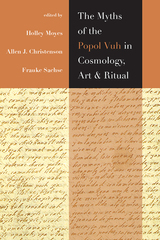 The Myths of the Popol Vuh in Cosmology, Art, and Ritual
Holley Moyes
University Press of Colorado, 2021 This volume offers an integrated and comparative approach to the Popol Vuh, analyzing its myths to elucidate the ancient Maya past while using multiple lines of evidence to shed light on the text. Combining interpretations of the myths with analyses of archaeological, iconographic, epigraphic, ethnohistoric, ethnographic, and literary resources, the work demonstrates how Popol Vuh mythologies contribute to the analysis and interpretation of the ancient Maya past.
The chapters are grouped into four sections. The first section interprets the Highland Maya worldview through examination of the text, analyzing interdependence between deities and human beings as well as the textual and cosmological coherence of the Popol Vuh as a source. The second section analyzes the Precolumbian Maya archaeological record as it relates to the myths of the Popol Vuh, providing new interpretations of the use of space, architecture, burials, artifacts, and human remains found in Classic Maya caves. The third explores ancient Maya iconographic motifs, including those found in Classic Maya ceramic art; the nature of predatory birds; and the Hero Twins’ deeds in the Popol Vuh. The final chapters address mythological continuities and change, reexamining past methodological approaches using the Popol Vuh as a resource for the interpretation of Classic Maya iconography and ancient Maya religion and mythology, connecting the myths of the Popol Vuh to iconography from Preclassic Izapa, and demonstrating how narratives from the Popol Vuh can illuminate mythologies from other parts of Mesoamerica.
The Myths of the Popol Vuh in Cosmology, Art, and Ritual is the first volume to bring together multiple perspectives and original interpretations of the Popol Vuh myths. It will be of interest not only to Mesoamericanists but also to art historians, archaeologists, ethnohistorians, iconographers, linguists, anthropologists, and scholars working in ritual studies, the history of religion, historic and Precolumbian literature and historic linguistics.
Contributors: Jaime J. Awe, Karen Bassie-Sweet, Oswaldo Chinchilla Mazariegos, Michael D. Coe, Iyaxel Cojtí Ren, Héctor Escobedo, Thomas H. Guderjan, Julia Guernsey, Christophe Helmke, Nicholas A. Hopkins, Barbara MacLeod, Jesper Nielsen, Colin Snider, Karl A. Taube
 The Myths of Zionism
John Rose
Pluto Press, 2004 This is a controversial book. It is a critical account of the historical, political and cultural roots of Zionism. John Rose shows how this powerful political force is based in mythology; ancient, medieval and modern. Many of these stories, as with other mythologies, have no basis in fact. However, because Zionism is a living political force, these myths have been used to justify very real and political ends -- namely, the expulsion and continuing persecution of the Palestinians. Chapter-by-chapter, John Rose scrutinises the roots of the myths of Zionism. Mobilising recent scholarship, he separates fact from fiction presenting a detailed analysis of their origins and development. This includes a challenge to Zionism's biblical claims using very recent and very startling Israeli archaeological conclusions. He provides a detailed exploration of Judaism's links to the Middle East. He shows clearly that Zionism makes many false claims on Jewish religion and history. He questions its rationale as a response to European anti-Semitism, and shows that, if there is ever to be peace and reconciliation in the land of Palestine, this intellectual dishonesty must be addressed.
|
|
